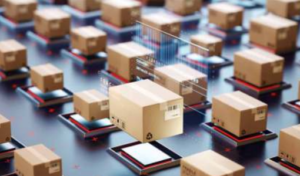
Artificial Intelligence (AI) is an emerging technology-driven tool to support various processes from Design & Development to Distribution & Delivery of Goods & Services with improved Quality, Safety, Security, and Punctuality, thereby helping to enhance consumer satisfaction and boost the trust-building process. Packaging & labeling, an integral part of the products, is also undergoing transformation by adopting such contemporary technologies to remain at par with the industry standards across the globe.
Artificial intelligence, as it sounds, does not really contain any artificial or arbitrary element; rather, it is a hybrid form of programming, which is built on numerous micro-level data and various information with multiple in-built logics. It is an elevated or augmented intelligent program and can be compared with a cluster of PLCs, where multiple logics are used for processing & analyzing data & information to take a decision or an action. Often, various machine learning data are also ingrained in AI programming to make it suitable for controlling different equipment and their functionalities. Ergonomic and demographical data derived from human nature and behavior are used to develop multiple logics for analyzing data internally. All these help the program behave as closely as the human brain but in a much quicker and smarter manner, eliminating subjectivity and variability.
 AI has inputs from multiple processes, data from various unit operations, and a lot of logical information, which helps to make rational decisions and appropriate actions, mimicking the human brain. The critical part of human intelligence is reasoning or judgment-based decision-making and actions. This is quite natural or spontaneous and varies from person to person depending on individual intellect, wisdom, and many external factors. Since the level of understanding, reasoning, and intelligence varies from person to person, the quality of judgment also varies while making a decision or taking action. Secondly, the time spent to take a decision or an action varies from person to person because of this difference in level of understanding and intelligence. It also varies from time to time depending on individual physical & mental status and a set of external factors. Perception, understanding, interpretation, and reasoning vary from person to person, along with their rational & analytical capabilities.
AI has inputs from multiple processes, data from various unit operations, and a lot of logical information, which helps to make rational decisions and appropriate actions, mimicking the human brain. The critical part of human intelligence is reasoning or judgment-based decision-making and actions. This is quite natural or spontaneous and varies from person to person depending on individual intellect, wisdom, and many external factors. Since the level of understanding, reasoning, and intelligence varies from person to person, the quality of judgment also varies while making a decision or taking action. Secondly, the time spent to take a decision or an action varies from person to person because of this difference in level of understanding and intelligence. It also varies from time to time depending on individual physical & mental status and a set of external factors. Perception, understanding, interpretation, and reasoning vary from person to person, along with their rational & analytical capabilities.
AI is developed for maintaining consistency with quality and swift actions with rational decisions to mitigate this risk of variability and to eliminate the human factor, especially in large-scale processes & operations. AI primarily works on data, information, and logic, something similar to our mind, which works on thoughts, feelings, and emotions. Our decisions and actions are derived from our thoughts, feelings, and emotions, which is the result of internal churning within our minds. Developing an AI program is a complex process, and data is one of the critical ingredients to develop it. From data capture, data transfer, data storage, data processing, data analysis, data transfer, and data exchange to data retrieval, all are part of the program and are primarily responsible for its functionality. Hence, data hygiene and integrity are essential for its effective functioning. The same is true for the information and logic, which should be authentic and rational for the successful development and functioning of any AI program.
Even though the Packaging Industry is widely spread across industries to protect the product and secure its stability, quality & safety across the entire supply chain, the majority of it is still under the MSME sector, and often, most of them cannot afford a costly and complex tool like AI in their operations. However, packaging users can explore a few areas to optimize the productivity and quality of their goods and services. We all are aware that packaging and Labelling are complementary. Hence, we need to include labeling in this discussion. The major role of Packaging & labeling is Brand Protection & Brand Promotion, establishing the Connectivity of the Product with the People, and supporting the entire Operation & Supply Chain System. There are a few areas where AI programs can be customized to deploy and optimize the packaging design from the primary packaging level to palletization. It can also help enhance productivity, minimize process cycle time, improve accuracy, and maintain consistency.
During the packaging design & development phase, AI can help select the right container-closure system (primary pack) or a better pack option with optimum volume and maximum level of protection. Similarly, it can also help in optimizing the dimensions of secondary and tertiary packs to maximize pallet capacity. It can also help in designing the packaging process through process mapping with minimum floor space utilization and process cycle time. However, to develop the program, a lot of product data, packaging material data, and data from each unit operation will be required, along with other associated information to analyze internally for an optimal workable option through its built-in logic. AI can also help standardize, harmonize, and optimize material specifications and process parameters for consistent results through automation, wherever feasible.
Artwork and Artwork Management System (AMS) are part of Labelling, which is an integral part of packaging. Nowadays, these are mostly being managed digitally for speed, accuracy, and quality. The entire AMS can be well managed through AI to eliminate variability across multiple sites of operations. AI can also help in managing a large volume of work with multiple languages for any global business. Generic updates, applicable to multiple product labeling, can also be managed well through an AI program. Checking of artworks, proofs, and commercial supplies of printed packaging materials can also be automated through AI tools. A well-programmed AI can also manage local and regional languages along with a common global language and translate it as per the end user’s requirement. Digital features on labeling, coupled with AI tools, can change the entire landscape.
 Quality functions associated with packaging materials, packaging operations, and finished packs can also be considered for management through AI tools to minimize or eliminate variability due to human factors. This can result in uniform quality of a product pack while reaching the end users. AI can also be deployed in areas like rejection analysis, process control, demand-supply management, forecasting, scheduling & planning, warehouse management, vendor management, etc. However, before deploying AI for any process, basic data, information, and logic need to be made part of the URS for the successful development of the program.
Quality functions associated with packaging materials, packaging operations, and finished packs can also be considered for management through AI tools to minimize or eliminate variability due to human factors. This can result in uniform quality of a product pack while reaching the end users. AI can also be deployed in areas like rejection analysis, process control, demand-supply management, forecasting, scheduling & planning, warehouse management, vendor management, etc. However, before deploying AI for any process, basic data, information, and logic need to be made part of the URS for the successful development of the program.
One of the critical components in developing AI lies in data hygiene and data integrity. Throughout the entire process, from data capture to retrieval, the quality and authenticity of data play a pivotal role in ensuring the effective functioning of AI systems. Similarly, the authenticity and rationality of information and logic embedded within AI programs are paramount for their successful development and operation.
Despite the widespread application of packaging across various industries to ensure product protection and stability throughout the supply chain, many players, particularly those in the Micro, Small, and Medium Enterprises (MSMEs) sector, may find it challenging to adopt expensive and complex AI tools. However, stakeholders in the packaging industry can explore avenues to optimize productivity and quality by leveraging AI in strategic areas.
Packaging and labeling, inherently intertwined, serve as critical components in brand protection, promotion, and establishing connectivity between products and consumers. By customizing AI programs to optimize packaging design from primary packaging to palletization, stakeholders can enhance productivity, minimize process cycle times, improve accuracy, and maintain consistency.
During the packaging design and development phase, AI can facilitate the selection of appropriate container-closure systems and packaging options, optimizing dimensions to maximize pallet capacity and minimize space utilization. Furthermore, AI can streamline packaging processes through process mapping, ensuring efficient floor space utilization and reduced cycle times.
However, the development of AI programs for packaging optimization requires extensive product data, packaging material data, and data from each unit operation. Additionally, comprehensive information is needed to analyze internally and determine optimal solutions through built-in logic. AI can also play a crucial role in standardizing, harmonizing, and optimizing material specifications and process parameters to ensure consistent results through automation.
 In the realm of labeling, Artwork and Artwork Management Systems (AMS) are integral components, often managed digitally for speed, accuracy, and quality. Leveraging AI can streamline AMS operations, eliminating variability across multiple sites of operation and efficiently managing large volumes of work across different languages for global businesses.
In the realm of labeling, Artwork and Artwork Management Systems (AMS) are integral components, often managed digitally for speed, accuracy, and quality. Leveraging AI can streamline AMS operations, eliminating variability across multiple sites of operation and efficiently managing large volumes of work across different languages for global businesses.
Moreover, AI can automate tasks such as checking artworks, proofs, and commercial supplies of printed packaging materials, enhancing quality control and ensuring compliance with regulatory standards. By managing local and regional languages alongside global languages, AI-driven labeling systems can cater to diverse consumer needs, further enhancing connectivity and brand engagement.
Quality control functions associated with packaging materials, operations, and finished products can also benefit from AI implementation, minimizing or eliminating variability introduced by human factors. By deploying AI in areas such as rejection analysis, process control, demand-supply management, forecasting, scheduling, planning, and warehouse management, stakeholders can optimize operations and enhance overall efficiency.
Beyond packaging and labeling, the potential applications of AI span a spectrum of supply chain functions, from demand forecasting and inventory management to vendor relations and warehouse optimization. However, successful deployment hinges on the incorporation of foundational data, information, and logic into the User Requirements Specification (URS), laying the groundwork for transformative Al-driven solutions.
While Al holds immense promise for streamlining processes and enhancing efficiency, it’s essential to acknowledge the irreplaceable role of human cognition, emotions, and intuition. As we embark on this journey of technological advancement, let us harness Al’s potential as a tool for our collective benefit, augmenting human capabilities and ushering in a new era of innoovation progress.
Another prospective area for AI application is the design & development of high-speed and high-end automatic packaging lines, wherein multiple machines are deployed for various unit operations from primary packaging to tertiary packaging. Such lines are often custom-designed with multiple units as per the users’ requirements for high-volume and high-value products. AI not only helps to automate the process but also eliminates rejection levels with minimum variabilities. The deployment of robotics in operations is an interesting example of an AI
application. Automated case packaging and palletizing are also possible areas for such applications.
Even though AI has huge potential to bring transformation to every level of our society, thoughts, feelings, and emotions are still in the precious possession of human beings, and that is why we are developing it for our own benefit.
Disclaimer: The views presented here are personal, based on my learnings and industrial exposure.
 ABOUT THE AUTHOR
ABOUT THE AUTHOR
Prabir K Das is an alumnus from the very 1st batch PG students of Indian Institute of Packaging (1985 – 1987), Mumbai. He served the industry for over 36 years, majorly in Pharmaceutical Industry, including Ranbaxy Laboratories and Mylan Laboratories. He had exposure in packaging design & development, technology transfer, artwork development & processing, packaging life cycle management, change management, automation, standardization & harmonization, process simplification, cost & quality improvement, track & trace (serialization) project, vendor development, documentation and other activities associated to Packaging and Labelling.
Exclusives
By Mike Teiler








